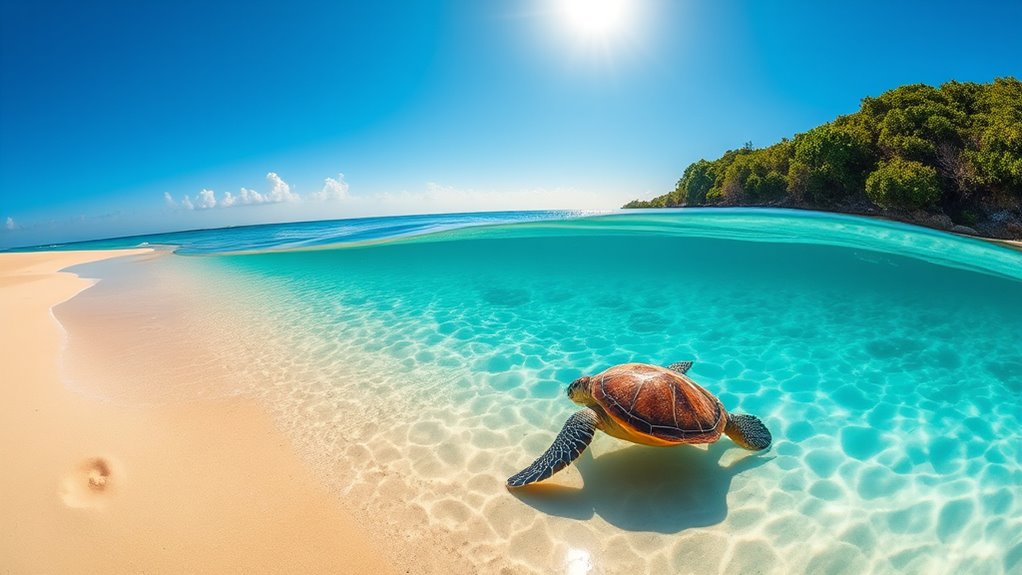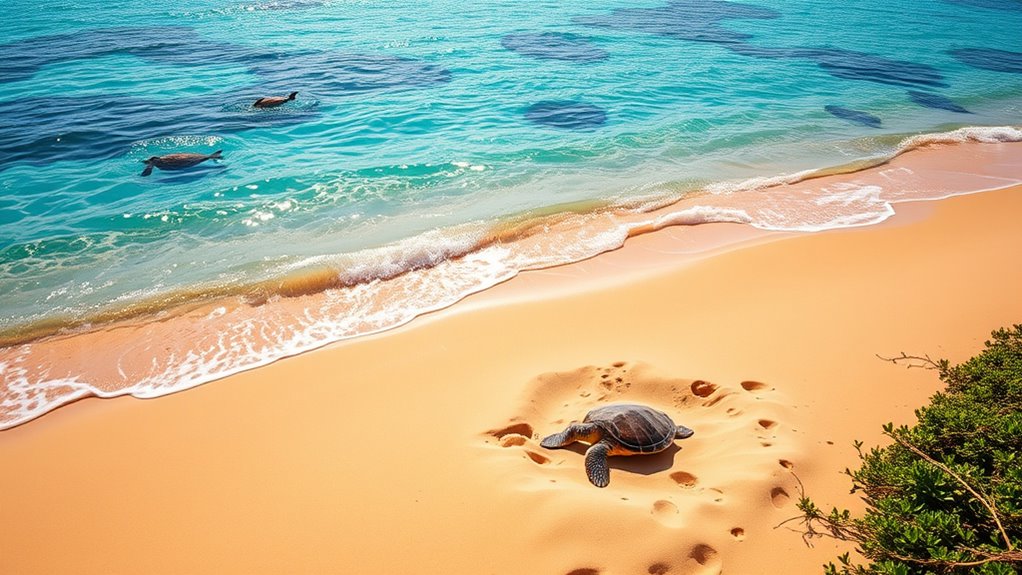The Great Barrier Reef is home to several sea turtle friendly beaches where you can witness these amazing creatures nesting from November to March. These beaches are carefully protected by local conservation efforts, including signage and fencing to safeguard their habitats. You’ll find that responsible eco-tourism helps fund these initiatives while supporting local communities. By exploring these areas, you’ll gain a deeper appreciation for marine ecosystems and their delicate balance. There’s so much more to discover about these stunning habitats.
Key Takeaways
- The Great Barrier Reef offers several protected nesting beaches for sea turtles, particularly during nesting season from November to March.
- Local conservation efforts and signage help safeguard nesting sites, minimizing human disturbance to turtles laying eggs.
- Responsible eco-tourism initiatives educate visitors about sea turtle conservation and support local economies while preserving habitats.
- Beaches with eco-friendly accommodations and tours promote sustainable practices, reducing the environmental impact on turtle nesting sites.
- Engaging with local cuisine, such as sustainably sourced seafood, enhances appreciation for marine ecosystems and supports conservation efforts.

Have you ever wondered where sea turtles choose to nest? If you’re lucky enough to find yourself near the Great Barrier Reef, you’re in for a treat. This iconic region isn’t just a stunning underwater paradise; it’s also a essential nesting ground for various sea turtle species. You might be surprised to learn that these ancient mariners are incredibly selective about their nesting sites, often returning to the same beaches year after year.
As you stroll along the sandy shores, keep an eye out for the signs of marine conservation efforts that help protect these magnificent creatures. Many local communities and organizations are dedicated to ensuring that the nesting sites remain undisturbed. You’ll often see fencing and signage, reminding beachgoers to tread lightly and respect the turtles’ space. Engaging with these conservation programs can also be a great way to deepen your appreciation for the delicate balance of coastal ecosystems.
When you think about coastal tourism, it’s important to realize how it can both benefit and challenge sea turtle conservation. On one hand, responsible eco-tourism can provide essential funding for conservation initiatives. When you visit these areas, your presence helps support local economies and encourages sustainable practices. Many tour operators are committed to educating visitors about the importance of protecting marine life, making your experience not just enjoyable but also impactful.
On the flip side, increased foot traffic and pollution can threaten nesting habitats. If you’re planning a trip, choose eco-friendly accommodations and tour operators that prioritize marine conservation. You’ll find that many hotels and resorts along the coast have adopted sustainable practices, ensuring that their operations don’t harm the environment.
While exploring the beaches, keep your eyes peeled for nesting activity. Generally, sea turtles nest during the warmer months, typically between November and March. You might even witness a mother turtle laying her eggs. Remember to observe from a distance and never disturb the turtles or their nests. Additionally, many beachgoers enjoy tasting local dishes like crab cakes, which showcase the region’s seafood while supporting sustainable practices.
Frequently Asked Questions
What Are the Best Times to Visit These Beaches for Turtle Watching?
The best times to visit for turtle watching are during the nesting season, which typically runs from November to March. You’ll catch turtles coming ashore to lay their eggs, especially at night. Additionally, keep an eye out during their seasonal migration, usually around the same months, when you might spot them swimming nearby. Plan your trips during these periods to maximize your chances of witnessing these incredible creatures in their natural habitat.
Are There Specific Conservation Programs for Sea Turtles in This Area?
You’ll find several conservation programs focused on sea turtle nesting in marine protected areas. As luck would have it, these programs often coincide with your visit, allowing you to witness incredible nesting activities. Organizations work tirelessly to monitor and safeguard nesting sites, educate the public, and rehabilitate injured turtles. By participating in these efforts, you can contribute to the preservation of these magnificent creatures and ensure their future in the ecosystem.
How Can I Report Sea Turtle Nesting or Sightings?
If you spot a sea turtle nesting or sighting, report it to local wildlife authorities or conservation groups immediately. They often have dedicated hotlines or online forms for nesting sites and sighting reports. Make sure to provide specific details, like the location and time of your sighting. Your information helps protect these amazing creatures and ensures their nesting sites are monitored and preserved for future generations. Don’t hesitate to get involved!
What Should I Do if I Encounter an Injured Sea Turtle?
If you encounter an injured sea turtle, don’t approach it directly. Instead, observe from a safe distance and avoid handling injuries yourself. Take note of its location and any visible injuries, then report your sighting to local wildlife authorities or a marine rescue organization. They’ll provide the necessary assistance to guarantee the turtle receives proper care. Remember, your report can help protect these amazing creatures and their habitats.
Are There Guided Tours Available for Sea Turtle Education?
Yes, there are guided eco tours available that focus on sea turtle conservation. You’ll find several organizations offering educational experiences where you can learn about these amazing creatures and their habitats. These tours often include expert-led discussions and opportunities to observe sea turtles in their natural environment. By participating, you’re not just enjoying a unique adventure; you’re also supporting efforts to protect these vulnerable species and their ecosystems.
Conclusion
So, as you stroll along the stunning beaches of the Great Barrier Reef, remember that these sandy havens are more than just beautiful—they’re crucial for sea turtles. By choosing to support conservation efforts and respecting their nesting sites, you can be a part of their incredible journey. After all, wouldn’t you want a safe place to call home? Let’s guarantee these majestic creatures can thrive for generations to come, one turtle-friendly beach at a time.










